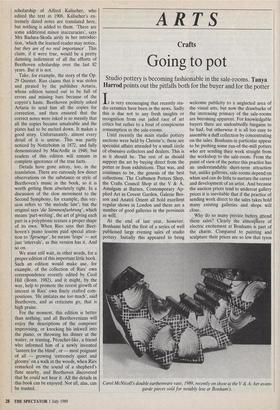ARTS
Crafts
Going to pot
It is very encouraging that recently stu- dio ceramics have been in the news. Sadly this is due not to any fresh insights or recognition from our jaded race of art critics but rather to a bout of conspicuous consumption in the sale-rooms.
Until recently the main studio pottery auctions were held by Christie's; these are specialist affairs attended by a small circle of obsessive collectors and dealers. This is as it should be. The rest of us should support the art by buying direct from the potter or from exhibitions. That was, and continues to be, the genesis of the best collections. The Craftsmen Potters Shop, the Crafts Council Shop at the V & A, Amalgam at Barnes, Contemporary Ap- plied Art in Covent Garden, Galerie Bes- son and Anatol Orient all hold excellent regular shows in London and there are a number of good galleries in the provinces as well.
At the end of last year, howeVer, Bonhams held the first of a series of well publicised large evening sales of studio pottery. Initially this appeared to bring welcome publicity to a neglected area of the visual arts, but now the drawbacks of the increasing primacy of the sale-rooms are becoming apparent. For knowledgable buyers there are undoubtedly bargains to be had, but otherwise it is all too easy to assemble a duff collection by concentrating on the sales. Bonhams in particular appear to be pushing some run-of-the-mill potters who are sending their work straight from the workshop to the sale-room. From the point of view of the potter this practice has an understandable short-term attraction but, unlike galleries, sale-rooms depend on whim and can do little to nurture the career and development of an artist. And because the auction prices tend to undercut gallery prices it is inevitable that if the practice of sending work direct to the sales takes hold many existing galleries and shops will close.
Why do so many private buten attend these sales? Clearly the atmosPere of electric excitement at Bonhams is part of the charm. Compared to painting and sculpture their prices are so low that tyros Carol McNicoll's double earthenware vase, 1989, recently on show at the V & A: her avant- garde pieces sold for notably less at Bonham's. feel able to have a flutter with impunity. When a roomful of the uninformed starts to bid it is natural that the most popular pots turn out to be little more than attractive bits of ornament. Perhaps that is why pieces by the fathers of studio pottery, Staite Murray and Bernard Leach, sell for Comparatively low prices. By the same token, early work by the great post-war potter, the late Hans Coper, will tend to fetch less than his all too recognisable thistle and spade shapes. Lucie Rie's more complex pots may make less than her glamorous white pieces, and so on. The sale-room taste appears to favour lifeless simple shapes, strong profiles and, ironi- cally enough, an almost machine-like fin- ish. Anyone who is not making straightfor- ward vessels or chic variants on the vessel form will do less well.
For example, the potters whom the Crafts Council has supported since the 1970s seem not to appeal to this World of Interiors set of buyers. In recent sales distinguished potters like Jacqui Poncelet, Glenys Barton, Richard Slee, Jill Crowley and Martin Smith have been sold for very little or have failed to meet their reserve prices. Another member of that genera- tion, Carol McNicoll, has just had a fine show at the V & A, but her prices were notably undercut by the Bonhams sale which coincided with it. The problem is that in a straight vessel sale more avant- garde work looks out of place and even excites the odd titter of embarrassed amusement. These sale-goers have con- servative tastes and it is striking that two of our greatest living potters — Ewen Hen- derson and Gordon Baldwin — both at high points in their careers, are not done justice in this atmosphere. Perhaps because of all this publicity some fine art galleries are beginning to have a few pots on sale. Again this seems a mixed blessing. Austin/Desmond have a few inferior Cardews and the work of Young Jason Watson. Spinks recently dot- ted pots around a show of 20th-century British paintings and watercolours. These were rather ordinary rural/oriental and seemed an odd debut for Spinks. If they wanted to patronise the school-of-Japan/ Leach type of potter why did they not choose the best — Jim Malone, Richard Batterham or Mike Dodd, for instance? Just now there is a splendid bottle with a whitish glaze by Dodd at the Craftsmen Potters Shop. But amidst all the razz- matazz the best younger followers of Ber- nard Leach are not singled out. Dodd lives in Cumbria and alongside his straightfor- ward utilitarian production wares are shelves of the most majestic stoneware bottles, whose extraordinary glazes are made of local minerals combined with wood-ash over a white slip. Everything about his way of life and the quiet deter- mined fashion in which he works, often in great hardship, serves to make the London sale-rooms seem very sorry places indeed.











































 Previous page
Previous page